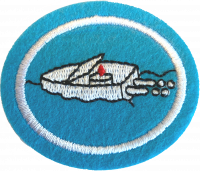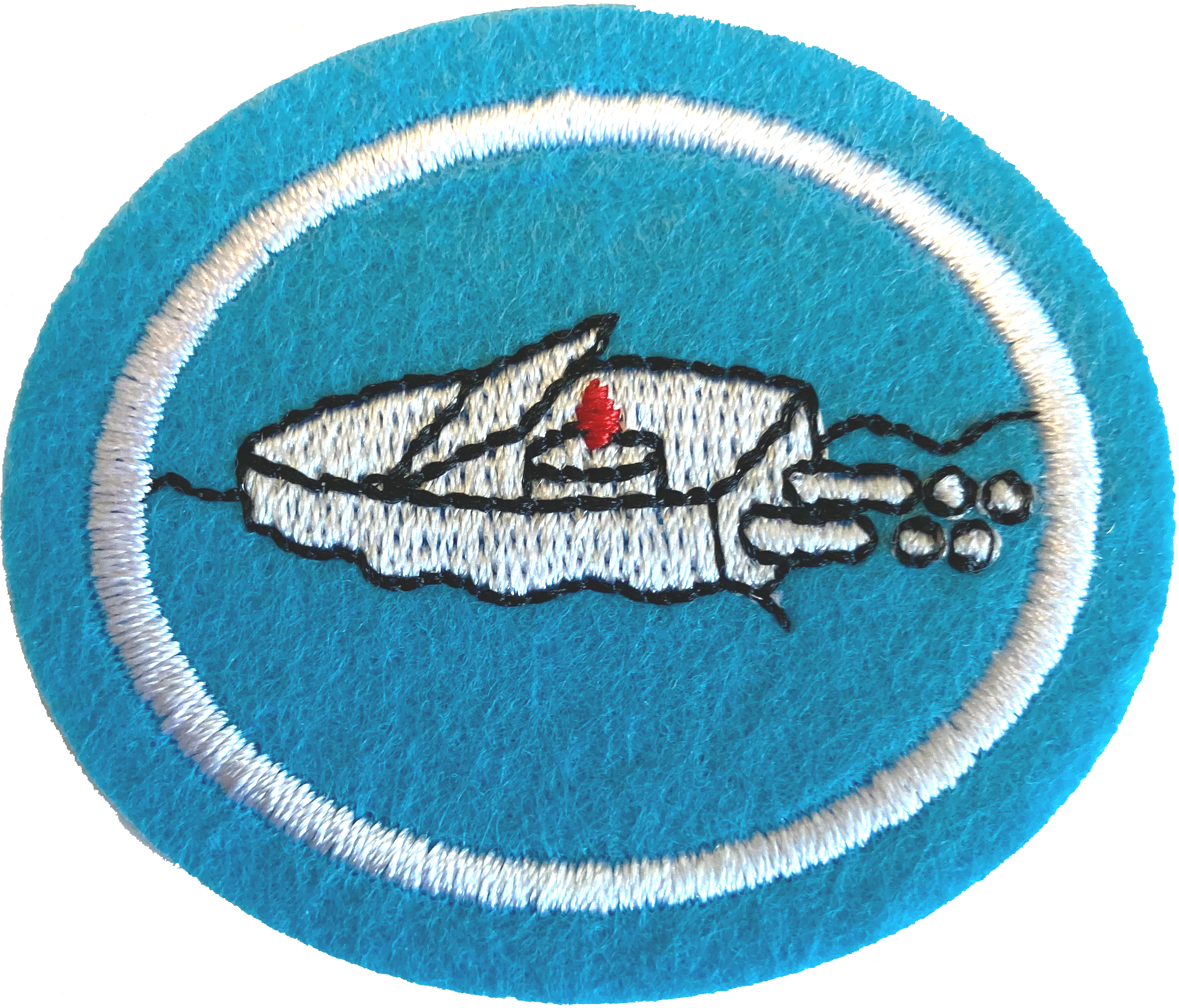Difference between revisions of "AY Honors/Toy Boat Regatta/Answer Key/es"
From Pathfinder Wiki
< AY Honors | Toy Boat RegattaAY Honors/Toy Boat Regatta/Answer Key/es
(Created page with "{{clear}}") |
|||
| (13 intermediate revisions by 2 users not shown) | |||
| Line 1: | Line 1: | ||
| − | + | {{HonorSubpage}} | |
| − | |||
| − | |||
| − | {{ | ||
| − | |||
| − | |||
| − | |||
| − | |||
| − | |||
| − | |||
| − | |||
| − | }} | ||
| − | |||
| − | |||
| − | |||
<section begin="Body" /> | <section begin="Body" /> | ||
{{ansreq|page={{#titleparts:{{PAGENAME}}|2|1}}|num=1}} | {{ansreq|page={{#titleparts:{{PAGENAME}}|2|1}}|num=1}} | ||
| Line 20: | Line 6: | ||
{{clear}} | {{clear}} | ||
| + | |||
| + | <div lang="en" dir="ltr" class="mw-content-ltr"> | ||
| + | ;Hull: The outer shell of the boat. | ||
| + | ;Mast: The tall pole that rises vertically from the boat to support the sails. | ||
| + | ;Boom: A horizontal pole attached to the mast. It can swing 360 degrees around the mast. | ||
| + | ;Mainsail: The sail attached to the mast along its front edge, and to the boom along its bottom edge. Its angle can be changed to catch (or release) the wind by moving the boom. | ||
| + | ;Jib: A fixed sail at the front of the boat attached to the mast by its rear edge, and to the very front of the boat in its front corner. | ||
| + | ;Keel: A weighted structure on the underside of the boat that keeps the boat from flipping over when the wind acts on its sails. Without a keel, the boat would just tip over when the wind hit the sail. | ||
| + | ;Rudder: A paddle-like structure on the back of the boat that is used for turning the boat. | ||
| + | </div> | ||
| + | |||
| + | <div lang="en" dir="ltr" class="mw-content-ltr"> | ||
| + | '''More terms:''' | ||
| + | ;Deck: The floor on the top side of the boat. | ||
| + | ;Bow: The front of the boat. | ||
| + | ;Stern: The back of the boat. | ||
| + | ;Starboard: The right side of the boat | ||
| + | ;Port: The left side of the boat. Large boats (and airplanes) dock on their port side. | ||
| + | ;Fore: Towards the bow of the boat. | ||
| + | ;Aft: Towards the stern of the boat. | ||
| + | ;Tiller: A control arm that can move the rudder. | ||
| + | ;Cockpit: A recessed area where the pilot sits to steer the boat. | ||
| + | </div> | ||
<noinclude></noinclude> | <noinclude></noinclude> | ||
| Line 25: | Line 34: | ||
{{ansreq|page={{#titleparts:{{PAGENAME}}|2|1}}|num=2}} | {{ansreq|page={{#titleparts:{{PAGENAME}}|2|1}}|num=2}} | ||
<noinclude></noinclude> | <noinclude></noinclude> | ||
| − | <!-- 2. | + | <!-- 2. Dibujar un plano para un bote de juguete impulsado por una bandita elástica (gomita, liga) de un diseño de su elección que muestre las características pertinentes que difieren de un bote de viento. --> |
{{clear}} | {{clear}} | ||
| Line 33: | Line 42: | ||
{{ansreq|page={{#titleparts:{{PAGENAME}}|2|1}}|num=3}} | {{ansreq|page={{#titleparts:{{PAGENAME}}|2|1}}|num=3}} | ||
<noinclude></noinclude> | <noinclude></noinclude> | ||
| − | <!-- 3. | + | <!-- 3. Ser capaz de describir el principio de Arquímedes y cómo este principio se aplica a todos los barcos. --> |
{{clear}} | {{clear}} | ||
| Line 45: | Line 54: | ||
{{ansreq|page={{#titleparts:{{PAGENAME}}|2|1}}|num=4}} | {{ansreq|page={{#titleparts:{{PAGENAME}}|2|1}}|num=4}} | ||
<noinclude></noinclude> | <noinclude></noinclude> | ||
| − | <!-- 4. | + | <!-- 4. Ser capaz de describir la primera ley del movimiento de Newton y cómo este principio se aplica a todos los barcos. --> |
{{clear}} | {{clear}} | ||
| Line 53: | Line 62: | ||
{{ansreq|page={{#titleparts:{{PAGENAME}}|2|1}}|num=5}} | {{ansreq|page={{#titleparts:{{PAGENAME}}|2|1}}|num=5}} | ||
<noinclude></noinclude> | <noinclude></noinclude> | ||
| − | <!-- 5. | + | <!-- 5. Ser capaz de describir la tercera ley del movimiento de Newton y cómo se aplica este principio a un barco (de vela) impulsado por viento. --> |
{{clear}} | {{clear}} | ||
| Line 61: | Line 70: | ||
{{ansreq|page={{#titleparts:{{PAGENAME}}|2|1}}|num=6}} | {{ansreq|page={{#titleparts:{{PAGENAME}}|2|1}}|num=6}} | ||
<noinclude></noinclude> | <noinclude></noinclude> | ||
| − | <!-- 6. | + | <!-- 6. Ser capaz de describir la diferencia entre energía potencial y energía cinética. Discutir cómo y cuándo un bote de juguete impulsado por una bandita elástica utiliza ambos tipos de energía. --> |
{{clear}} | {{clear}} | ||
| Line 69: | Line 78: | ||
{{ansreq|page={{#titleparts:{{PAGENAME}}|2|1}}|num=7}} | {{ansreq|page={{#titleparts:{{PAGENAME}}|2|1}}|num=7}} | ||
<noinclude></noinclude> | <noinclude></noinclude> | ||
| − | <!-- 7. | + | <!-- 7. Usar materiales reciclados para hacer al menos un bote de juguete impulsado por viento (de vela) y al menos un bote de juguete impulsado por bandita elástica. Cada bote de juguete no será más de 4 pulgadas (10 cm) de ancho y será adecuado para viajar en un carril de agua de 6 pulgadas (15 cm) de ancho. --> |
{{clear}} | {{clear}} | ||
| Line 77: | Line 86: | ||
{{ansreq|page={{#titleparts:{{PAGENAME}}|2|1}}|num=8}} | {{ansreq|page={{#titleparts:{{PAGENAME}}|2|1}}|num=8}} | ||
<noinclude></noinclude> | <noinclude></noinclude> | ||
| − | <!-- 8. | + | <!-- 8. Participar en una regata organizada de botes impulsados por viento (de vela) utilizando un bote que haya construido para completar esta especialidad. --> |
{{clear}} | {{clear}} | ||
| Line 85: | Line 94: | ||
{{ansreq|page={{#titleparts:{{PAGENAME}}|2|1}}|num=9}} | {{ansreq|page={{#titleparts:{{PAGENAME}}|2|1}}|num=9}} | ||
<noinclude></noinclude> | <noinclude></noinclude> | ||
| − | <!-- 9. | + | <!-- 9. Participar en una regata organizada de botes con banditas elásticas utilizando un bote que haya construido para completar esta especialidad. --> |
{{clear}} | {{clear}} | ||
| Line 93: | Line 102: | ||
{{ansreq|page={{#titleparts:{{PAGENAME}}|2|1}}|num=10}} | {{ansreq|page={{#titleparts:{{PAGENAME}}|2|1}}|num=10}} | ||
<noinclude></noinclude> | <noinclude></noinclude> | ||
| − | <!-- 10. | + | <!-- 10. Identificar y contar una historia breve de al menos dos casos en la Biblia que describen botes/objetos flotantes y dos que desafían el principio de Arquímedes. --> |
{{clear}} | {{clear}} | ||
| Line 100: | Line 109: | ||
{{CloseReq}} <!-- 10 --> | {{CloseReq}} <!-- 10 --> | ||
<noinclude></noinclude> | <noinclude></noinclude> | ||
| − | == | + | ==Referencias== |
| − | |||
| − | |||
<noinclude></noinclude> | <noinclude></noinclude> | ||
| − | + | {{CloseHonorPage}} | |
Latest revision as of 23:45, 18 July 2022
Regata de botes de juguete
Nivel de destreza
1
Año
2021
Version
31.12.2025
Autoridad de aprobación
División Norteamericana
1
Dibujar un esquema de un barco (de vela) impulsado por viento que muestre las características pertinentes y cómo funcionan. Las características deben incluir pero no limitarse a botavara, casco, foque, quilla, vela mayor, mástil y timón. ¿Cómo las características que se eliminan comúnmente de los botes de juguete afectan la funcionalidad?
- Hull
- The outer shell of the boat.
- Mast
- The tall pole that rises vertically from the boat to support the sails.
- Boom
- A horizontal pole attached to the mast. It can swing 360 degrees around the mast.
- Mainsail
- The sail attached to the mast along its front edge, and to the boom along its bottom edge. Its angle can be changed to catch (or release) the wind by moving the boom.
- Jib
- A fixed sail at the front of the boat attached to the mast by its rear edge, and to the very front of the boat in its front corner.
- Keel
- A weighted structure on the underside of the boat that keeps the boat from flipping over when the wind acts on its sails. Without a keel, the boat would just tip over when the wind hit the sail.
- Rudder
- A paddle-like structure on the back of the boat that is used for turning the boat.
More terms:
- Deck
- The floor on the top side of the boat.
- Bow
- The front of the boat.
- Stern
- The back of the boat.
- Starboard
- The right side of the boat
- Port
- The left side of the boat. Large boats (and airplanes) dock on their port side.
- Fore
- Towards the bow of the boat.
- Aft
- Towards the stern of the boat.
- Tiller
- A control arm that can move the rudder.
- Cockpit
- A recessed area where the pilot sits to steer the boat.
2
Dibujar un plano para un bote de juguete impulsado por una bandita elástica (gomita, liga) de un diseño de su elección que muestre las características pertinentes que difieren de un bote de viento.
3
Ser capaz de describir el principio de Arquímedes y cómo este principio se aplica a todos los barcos.
4
Ser capaz de describir la primera ley del movimiento de Newton y cómo este principio se aplica a todos los barcos.
5
Ser capaz de describir la tercera ley del movimiento de Newton y cómo se aplica este principio a un barco (de vela) impulsado por viento.
6
Ser capaz de describir la diferencia entre energía potencial y energía cinética. Discutir cómo y cuándo un bote de juguete impulsado por una bandita elástica utiliza ambos tipos de energía.
7
Usar materiales reciclados para hacer al menos un bote de juguete impulsado por viento (de vela) y al menos un bote de juguete impulsado por bandita elástica. Cada bote de juguete no será más de 4 pulgadas (10 cm) de ancho y será adecuado para viajar en un carril de agua de 6 pulgadas (15 cm) de ancho.
8
Participar en una regata organizada de botes impulsados por viento (de vela) utilizando un bote que haya construido para completar esta especialidad.
9
Participar en una regata organizada de botes con banditas elásticas utilizando un bote que haya construido para completar esta especialidad.
10
Identificar y contar una historia breve de al menos dos casos en la Biblia que describen botes/objetos flotantes y dos que desafían el principio de Arquímedes.


